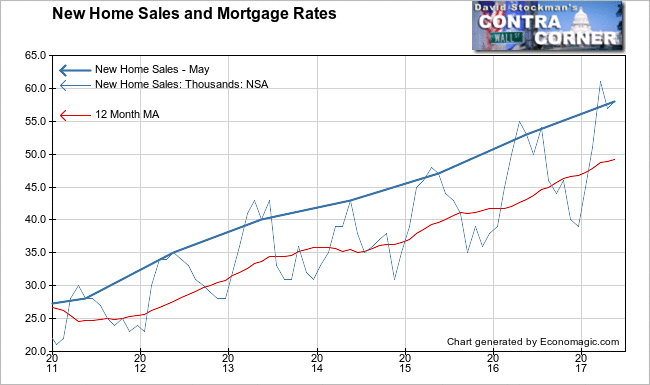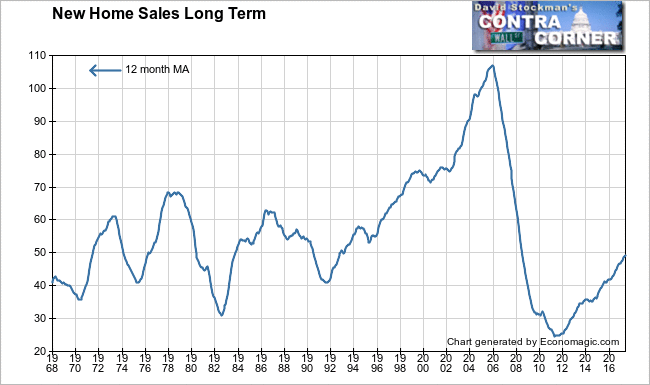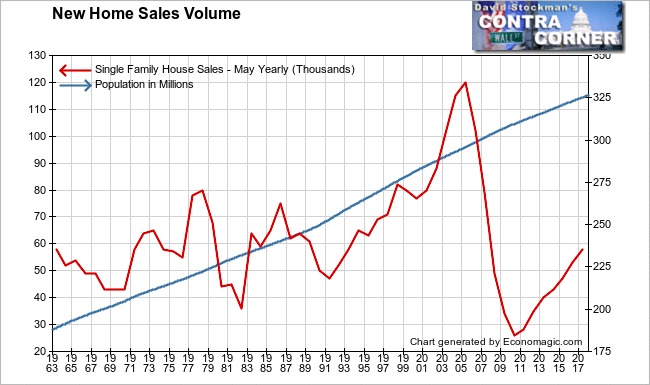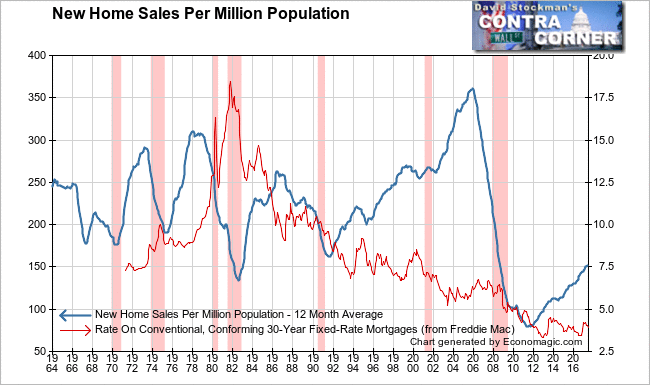The Wall Street Journal got pretty excited about the Commerce Department’s report on new home sales late last month. As it turns out, there was some method to their madness. Sales rose a bit, and price inflation raged in May. But don’t get too bullish, housing fans. This is typically what happens when the Fed raises interest rates late in a business and housing cycle. It triggers a buying surge that leads to exhaustion of demand, and ultimately, collapse. Meanwhile the news coverage of the trend become breathless and almost maniacal :

The Journal’s report was even more manic than the market.
New-home sales rose in May and prices hit a record level, more evidence of a housing market characterized by strong demand and tight inventories.
Purchases of new, single-family homes — a narrow slice of all U.S. home sales — rose 2.9% to a seasonally adjusted annual rate of 610,000 in May, the Commerce Department said Friday.
From a year earlier, new-home sales rose 8.9% in May and so far this year have climbed 12.2%, indicating the market for new homes appears to be picking up.
“The name of the housing market game over the past few years has been low supply, not low demand,” said Ralph McLaughlin, chief economist at Trulia. “As home sales continue to pick up, that’s further evidence that we have a supply problem, not a demand problem.”
The report highlighted that the median sale price was “the highest on record.” If sale prices have far exceeded the levels of the top of the Great Housing Bubble, wouldn’t this be a bubble? Household incomes certainly have not kept pace.
And by the way, as is customary in media reports on housing prices, nowhere in the report did the word “inflation” appear. The data showed that the annual new home sale price inflation rate hit 16%.
But you can relax. The 12 month average inflation rate is just 6%. That’s similar to the inflation rate of 6% in existing home sales, which is about 3 times faster than household income growth.
We’ll take a deeper dive into housing inflation in another report. For now the focus is on sales volume.
Another pundit quote in the Journal’s report highlighted a condition I have covered in previous reports. “The pressure to close deals quickly, which has afflicted the existing home sales market, is also seeping into the market for new homes.”
In other words, deals are being pushed to close quickly that would not have made the grade in more rational environments. Credit standards are being relaxed so that more deals can get done before rising rates choke off the market.
We saw nearly identical views expressed and similar conditions at the top of the Great Housing Bubble in 2006. The mantra then was that there was too much demand to allow prices to come down. Today it is that there’s not enough supply and plenty of demand causing prices to rise.
But demand is extremely fragile. In this crazed environment, buyers are stretching to the absolute limit of what they can afford, and sometimes beyond. Bank executives are pushing mortgage underwriters to approve marginal credits that don’t meet income qualification standards. They are extorting appraisers to approve sales contract values that are going through the roof.
Mortgage rates will rise after the Federal debt limit is increased and a mountain of new Treasury supply hits the market. That will cause bond yields to rise. The Fed shedding assets from its balance sheet will also put upward pressure on bond yields. Mortgage rates are tied to Treasury bond yields. They’ll move up as Treasury yields move up.
That will force many buyers out of the market. Demand will dry up. Suddenly, supply won’t look so tight.
At some point in the next several months builders will suddenly find that there’s a shortage of buyers. The houses that they are building on spec, which are getting snapped up right now, will start to go unsold. Deals will fall through as some buyers walk away or fail to get a mortgage. Deals will also fall out when rates rise, if buyers haven’t locked the rate, or if the house isn’t finished within the period of the rate lock.
Builders will lower their prices to move inventory as it begins to build and private home sellers who really need to sell will start lowering their asking prices. Supply will multiply as demand dries up. The rout will be on. What looked like a supply shortage will suddenly become a glut.
In analyzing the market, we look at the actual, not seasonally adjusted data. That’s as opposed to the seasonally adjusted (SA), manipulated data that purports to accurately represent the trend without the normal seasonal fluctuations. Sometimes the SA data does and sometimes it doesn’t. The only way to tell is to look at the actual NSA data. The headline numbers, which are always the seasonally adjusted, idealized impression of the trend are, in reality, tangential.
As opposed to the breathlessness of the media reports, the real story here is pretty mundane. Unit sales volume totaled an estimated 58,000 in May. That was up 1,000 units compared with April. Is that good? It was better than May 2016 which saw a 2000 unit drop from April. A 1,000 unit sales gain is also better than the 10 year average for the month, which is a drop of 500 units. But even that is misleading. The 10 year average was skewed by a 15,000 unit drop in May 2010. Take that out, and this month was absolutely average. It was nothing special.
Somehow the media saw “strong demand.” I guess the question is, “Strong relative to what?” The year to year gain was 9.4%. That’s big, but a lot lower than the double digit annual increase in most of the last year. It was not as big as the Journal’s report of a 12.2% gain based on seasonally adjusted data. Because the Journal viewed only seasonally adjusted data, it hoodwinked the public in saying that sales gained 8.9% in May and were up 12.2% on the year. It completely failed to mention the slowing in sales growth momentum.
If you only look at the period since the housing crash, you would get the idea that these really are great numbers, in a wonderfully stable trend. Sales have doubled since the bottom of the housing market crash in 2011.

But you would be missing something. It’s called perspective. That’s something that the mainstream media almost never bothers with. In fact, sales are only back to the average levels of 25 to 50 years ago. And this with the help of not only falling mortgage rates, but all time record low mortgage rates for the entire period of this recovery.

Those low and falling rates are the only thing that has supported demand, as household incomes have stagnated. When rates rise, demand will crater because house prices have inflated far beyond the limits of affordability for most people. Any rise in mortgage rates will only exacerbate that.
It gets worse when the sales volume data is viewed on a population adjusted basis. New home sales kept pace with population growth until 2007. They have never recovered to trend. As the recovery progressed, not enough high paying jobs were created to enable new home sales to return to trend. This is a clear illustration of how more people are falling behind in this recover. The middle class is shrinking. The American dream of home ownership is increasingly out of reach.

The sales rate per million people has barely recovered to the level of the 1982 recession, when mortgage rates were 17-18%. If this is recovery, I can’t wait to see what the next recession looks like.

The Commerce Department report on new home sales is a treasure trove of useful data. We’ll take a deeper dive into it in a subsequent report.


